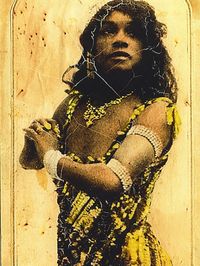Difference between revisions of "Salome's Dance (1908 Overton Walker), solo dance"
| Line 5: | Line 5: | ||
==Abstract== | ==Abstract== | ||
In | In 1908 Aida Overton-Walker contributed to the "Salomania" of those years with her performance of the “Salome” dance at Hammerstein’s Victoria Theatre. As an African-American dancer she was well aware of how the roles she played affected race relations of the time. Her portrayal of the [[Salome]] character was very different from that of the other dancers and actresses of her time. She worked hard to break the stereotypes of black women as immoral and oversexed. In particular, she coordinated her movements and facial expressions in order to express the internal emotions and thoughts of the characters she was portraying. Aida's performance was so successful that by public demand she was asked to perform two additional weeks than original planned. | ||
==Original cast== | ==Original cast== | ||
Revision as of 15:59, 26 March 2017
The Vision of Salome (1912) is a vaudeville ballet by Aida Overton-Walker (chor.).
Abstract
In 1908 Aida Overton-Walker contributed to the "Salomania" of those years with her performance of the “Salome” dance at Hammerstein’s Victoria Theatre. As an African-American dancer she was well aware of how the roles she played affected race relations of the time. Her portrayal of the Salome character was very different from that of the other dancers and actresses of her time. She worked hard to break the stereotypes of black women as immoral and oversexed. In particular, she coordinated her movements and facial expressions in order to express the internal emotions and thoughts of the characters she was portraying. Aida's performance was so successful that by public demand she was asked to perform two additional weeks than original planned.
Original cast
Editions, performances
Premiered in New York, NY: Victoria Theatre, 1912.
